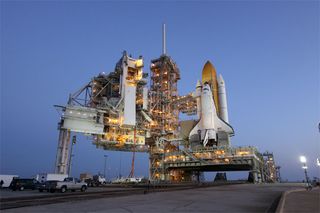NASA Sets April 5 Launch Date for Shuttle Discovery

Thisstory was updated at 7:36 p.m. ET.
Thespace shuttle Discovery is set to launch April 5 on one of NASA?s few remainingshuttle flights to the International Space Station, mission managersannounced Friday after settling concerns over potential valve leaks.
Discoveryis slated to blastoff from a seaside launch pad at the Kennedy Space Center in Florida at6:21 a.m. EDT (1021 GMT) on Easter Monday. It is one of NASA?s final fourshuttle missions before the fleet is retired later this year.
?Weare ready to fly,? said NASA?s space operations chief Bill Gerstenmaier in abriefing late Friday.
Discoverywill launch seven astronauts on a 13-day mission to deliver a cargo modulepacked with supplies, new science experiments and other vital gear to theInternational Space Station. The shuttle is also hauling large spare parts forthe station, pieces so big that they will take three spacewalks to install.
Shuttlevalves pass test
Earlierthis month, engineers found what appeared to be a leakor stuck valve in the helium lines that pressurize the aft-mountedthrusters on Discovery's right rear engine pod. Since then, they performed moretests of other hardware associated with the system, and found it in goodworking order.
Get the Space.com Newsletter
Breaking space news, the latest updates on rocket launches, skywatching events and more!
Missionmanagers discussed the tests and decided the system was working fine enough topress ahead with Discovery?s mission, even though they still aren?t sure whatcaused the initial glitch.
?Afterlooking at all the testing on it, we?re very confident that the system willwork as designed,? NASA?s shuttle program manager John Shannon told reporters.
Someshuttle experts did express concern that more tests might be needed, buteventually agreed that Discovery was safe to fly. The decision to press forwardtoward launch was unanimous, Shannon said.
Therisk of damage from loose ceramic inserts wedged between the protective heatshield tiles around Discovery?s flight deck windows was also found to be low,NASA officials added. Engineers tested the ceramic inserts after one shookslightly loose during the space agency?s last shuttle flight in February.
Discovery?sSTS-131 mission is the second of five finalshuttle missions planned for this year before the aging three-orbiter fleetis retired in the fall. One mission, aboard the shuttle Endeavour, successfullyflew to the station in February to add a new room and a seven-windowobservation deck that gives astronauts stunning viewsof Earth from space.
Allfour of the remaining missions are also aimed at completing construction of the$100 billion International Space Station. The station, a cooperative effort by16 different countries, is 98 percent complete, with several new modules and other parts to beadded this year.
Discoveryis also slated to fly the final shuttle mission, which is due to launch Sept.16 on NASA?s current schedule.
Fewflights remain
Spaceshuttle managers have repeatedly said that they are confident they will be ableto complete the remaining four shuttle flights in 2010 as planned. However, areport issued Thursday by NASA?s Inspector General office found that given thehistory of shuttle flight challenges and delays, a shuttleretirement date in January or February of 2011 is more likely.
ButShannon stressed that barring any unforeseen and lengthy delays, the shuttlefleet is on track to retire on Sept. 31 as planned.
?Wetake each flight one at a time,? Shannon said, adding that it is the fuel tanksand other hardware for each mission which drives the schedule. ?The tanks areshowing up on time to support a last launch in September.?
NASAis retiring its orbiter fleet without a clear-cut successor. In February, U.S.President BarackObamaordered the agency to cancel its Constellation program developing the new Orionspacecraft and Ares rockets slated to replace the shuttle fleet.
Instead,the president proposed setting aside $6 billion over the next five years tospur new commercially built spaceships to fly Americans into orbit. The goal isto free up NASA to tackle more ambitious missions beyond low-Earth orbit, suchas manned flights to the moon, asteroids or Mars.
PresidentObamais expected to discuss his new space plan in more detail during a space summitin Florida scheduled for April 15. That meeting, if all goes according to plan,would occur a few days before the planned landing of Discovery at the KennedySpace Center.
Gerstenmaiersaid that President Obama?s presence in Florida should not disrupt the focus ofshuttle personnel during Discovery?s flight.
?Theteams are pretty focused ... folks really know what they need to go do,?Gerstenmaier said. ?I don?t see any impact there at all.?
Discovery?sseven-astronaut crew will travel from Houston to the shuttle?s Florida launchsite next week to begin preparing the upcoming mission.
- Images - Shuttle Discovery's Midnight Launch
- Final Countdown: A Guide to NASA's Last Space Shuttle Missions
- Video Show - Riding the Space Shuttle
Join our Space Forums to keep talking space on the latest missions, night sky and more! And if you have a news tip, correction or comment, let us know at: community@space.com.

Tariq is the Editor-in-Chief of Space.com and joined the team in 2001, first as an intern and staff writer, and later as an editor. He covers human spaceflight, exploration and space science, as well as skywatching and entertainment. He became Space.com's Managing Editor in 2009 and Editor-in-Chief in 2019. Before joining Space.com, Tariq was a staff reporter for The Los Angeles Times covering education and city beats in La Habra, Fullerton and Huntington Beach. In October 2022, Tariq received the Harry Kolcum Award for excellence in space reporting from the National Space Club Florida Committee. He is also an Eagle Scout (yes, he has the Space Exploration merit badge) and went to Space Camp four times as a kid and a fifth time as an adult. He has journalism degrees from the University of Southern California and New York University. You can find Tariq at Space.com and as the co-host to the This Week In Space podcast with space historian Rod Pyle on the TWiT network. To see his latest project, you can follow Tariq on Twitter @tariqjmalik.
